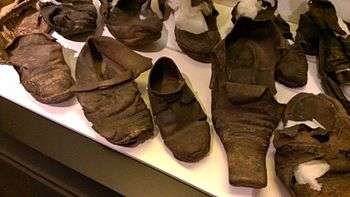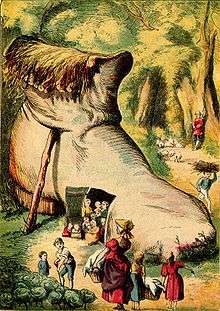Concealed shoes

Concealed shoes hidden in the fabric of a building have been discovered in many European countries, as well as in other parts of the world, since at least the early modern period. Independent researcher Brian Hoggard has observed that the locations in which these shoes are typically found – in chimneys, under floors, above ceilings, around doors and windows, in the roof – suggest that some may have been concealed as magical charms to protect the occupants of the building against evil influences such as demons, ghosts and witches. Others may have been intended to bestow fertility on a female member of the household, or been an offering to a household deity.
Concealed shoes have been found in many types of building, including country houses, public houses, a Benedictine monastery and a Baptist church. The earliest yet reported was discovered behind the choirstalls in Winchester Cathedral, which were installed in 1308.
Northampton Museum maintains a Concealed Shoe Index, which by 2012 contained 1900 reports of discoveries, mostly from Britain and almost half from the 19th century. The overwhelming majority have been worn, and many have been repaired. Most finds are of single shoes, about half of them belonging to children.
The custom of concealing shoes in the structure of a building appears to have more or less died out some time during the 20th century.
Background
Since at least the early modern period it was a common custom to hide objects such as written charms, dried cats, horse skulls, and witch bottles in the structure of a building,[1] but concealed shoes are by far the most common items discovered.[2] Archaeologist Brian Hoggard has observed that the locations in which these shoes are found suggest that at least some were concealed as magical charms to protect the occupants of the building against evil influences.[1] Such hidden caches of objects are known by archaeologists as spiritual middens.[3]
Northampton Museum maintains a Concealed Shoe Index,[lower-alpha 1] which by 1998 contained more than 1100 reports of concealed shoes, mostly from Britain but some from as far away as Canada.[5] By 2012 it had increased to 1900 entries,[6] of which almost half date from the 19th century.
The custom of concealing shoes in the fabric of a building appears to have more or less died out some time during the 20th century, although not entirely.[5] The shoe manufacturer Norvic incorporated a pair of their women's high-leg boots in the foundations of their new factory built in 1964, and an even more recent account comes from Knebworth House, where in 1991 an estate worker's shoe replaced an "old court shoe" that had been discovered behind some panelling.[7] Nevertheless, only 50 post-1900 instances of concealed shoes have been recorded.[5]
Location of finds
Concealed shoes have been discovered in several European countries,[6] as well as in North America[8] and Australia.[9] Although deposits have been found throughout the United States they are concentrated in New England and the northeastern United States, the latter of which was first colonised by immigrants from the East Anglia region of England.[10][lower-alpha 2]
An analysis of the Concealed Shoe Index maintained by Northampton Museum, conducted by June Swann and published in 1996,[7] reveals that the most common place of concealment is the chimney, fireplace or hearth (26.2 per cent), followed by under the floor or above the ceiling (22.9 per cent), and almost as many concealed in the roof. Shoes have also been found around doors and windows, under the stairs, and among the foundations. Concealed shoes have been discovered in many types of building: country cottages, town houses, manor houses, hospitals, workhouses, factories, public houses, and two Oxford colleges, St John's and Queen's. They have even been found in ecclesiastical buildings, including a Benedictine monastery in Germany and a Baptist church in Cheshire, England.[7]
The earliest concealed shoe yet reported was discovered behind the choirstalls in Winchester Cathedral, which were installed in 1308.[7]
Characteristics
Most of the concealed shoes found to date are made of leather, but wooden clogs and rubber galoshes have also been reported, among others. The overwhelming majority (almost 98 per cent) have been worn, and many show signs of repair. All ages are represented in the shoe sizes, from babies to adults, but there is little difference in the ratio of adult male to female shoes, at 21.5 per cent and 26.5 per cent respectively. Most finds are of single shoes, but some pairs have also been discovered.[7] About half of the shoes so far discovered belonged to children.[11]
Apart from their significance to folklore, concealed shoes give an important insight into what ordinary people have historically worn on their feet.[6]
Explanations
Several theories have been advanced to account for the incorporation of shoes into the fabric of a building, one of which is that they served as some kind of fertility charm. There is a long-standing connection between shoes and fertility, perhaps exemplified by the nursery rhyme, "There was an Old Woman Who Lived in a Shoe", and the custom of casting a shoe after a bride as she leaves for her honeymoon[12] or attaching shoes to the departing couple's car.[13] Archaeologist Ralph Merrifield has observed that in the English county of Lancashire women who wished to conceive might try on the shoes of a woman who had just given birth,[14] a custom known as smickling.[15]

Another theory, and the one favoured by most scholars, argues that shoes were concealed to protect against evil influences such as demons, ghosts, witches, and familiars. Witches were believed to be attracted by the human scent of a shoe, and after entering one found themselves trapped, as they are unable to reverse.[3] Merrifield has suggested that an unofficial 14th-century English saint, John Schorne, may have been the source of the belief that shoes had the power to protect against evil. Schorne was said to have succeeded in trapping the Devil in a boot, a legend that may have its origin in a more ancient folk belief,[5] which the Church was attempting to convert into an "approved Christian rite".[16]
Archaeologist and architectural historian M. Chris Manning has proposed that the immurement of shoes, garments, and other objects may be related to the belief in a household deity or helpful spirit found throughout northern Europe from Ireland to western Russia.[17] According to Manning, Schorne's use of a shoe to capture or repel a troublesome spirit may have called upon an existing belief in the power of shoes and other garments to attract, repel, or "lay" such spirits. The brownie and hob, domestic fairies found in England and Scotland, could be driven off by a gift of clothing. In Russia, it was said that the domovoi, a helpful domestic spirit, could be attracted to a home with an old boot or bast shoe placed under the stove or hung in the yard. The belief in household spirits is closely tied to the concept of the familiar, which in turn is linked to the belief in demons and other harmful spirits.
Thirteen of the shoes in Swann's analysis (only a small fraction of the thousands of concealed shoes reported worldwide) were buried in the foundations of a building. She has alluded to a possible connection with the Carthaginian practice of putting human babies in the foundations of their buildings, and suggested that the shoes may have acted as a substitute for the person.[7]
See also
References
Notes
- ↑ Northampton was once a major shoemaking centre.[4]
- ↑ There were relatively few witch trials and executions in England compared to other European countries, but East Anglia did experience one of the most intense witch hunts in the country, as for a time did New England. [10]
Citations
- 1 2 Hoggard (2004), p. 167
- ↑ Hoggard (2004), p. 178
- 1 2 Kelly, Eamonn P. (Autumn 2012), "Trapping Witches in Wicklow", Archaeology Ireland: 16–18, JSTOR 23320106, (subscription required (help))
- ↑ "Boot and Shoe Quarter Conservation Area". Northampton Borough Council. Retrieved 10 November 2013.
- 1 2 3 4 Hoggard (2004), p. 179
- 1 2 3 "Concealed shoes", Northampton Museums & Art Gallery, retrieved 29 October 2012
- 1 2 3 4 5 6 Swann, June (1996), "Shoes Concealed in Buildings", Costume (30): 56–69, retrieved 10 November 2013
- ↑ Manning (2012), p. ii
- ↑ "Concealed shoes: Australian settlers and an old superstition", BBC, retrieved 22 October 2013
- 1 2 Manning (2012), p. 353
- ↑ Pitt, Fiona (February 1998), "Builders, Bakers and Madhouses: Some Recent Information From the Concealed Shoe Index" (PDF), Archaeological Leather Group Newsletter, pp. 3–6
- ↑ Opie & Opie (1997), pp. 522–524
- ↑ Jack (2008), There Was an Old Woman Who Lived in a Shoe
- ↑ Merrifield (1987), p. 134
- ↑ Dixon-Smith, Denise (Spring 1990), "Concealed Shoes" (PDF), Archaeological Leather Group Newsletter (6), pp. 2–4
- ↑ Manning (2012), pp. 352–353.
- ↑ Manning (2012), pp. 350–351
Bibliography
- Hoggard, Brian (2004), "The archaeology of counter-witchcraft and popular magic", in Davies, Owen; De Blécourt, William, Beyond the Witchtrials: Witchcraft and Magic in Enlightenment Europe, Manchester University Press, ISBN 978-0-7190-6660-3
- Jack, Albert (2008), Pop Goes the Weasel: The Secret Meanings of Nursery Rhymes (eBook), Penguin, ISBN 978-0-14-190930-1
- Manning, M. Chris (2012), Homemade Magic: Concealed Deposits in Architectural Contexts in the Eastern United States (Masters thesis), Ball State University
- Merrifield, Ralph (1987), The Archaeology of Ritual and Magic, Batsford, ISBN 978-0-7134-4870-2
- Opie, Iona; Opie, Peter (1997), The Oxford Dictionary of Nursery Rhymes (2nd ed.), Oxford University Press, ISBN 978-0-19-860088-6
External links
- Brian Hoggard's site on concealed shoes and other apotropaic objects
- Hidden Footsteps: Analysis of a Folk Practice
- Hoosier Footprints: Concealed Shoes in Indiana
- The People's Collection Wales 2011